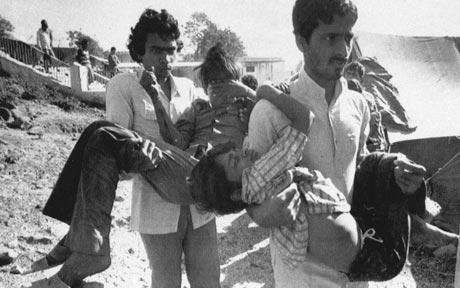LIE & LET DIE (Part 3)
The tale of disinformation emanating from Union Carbide in an effort to limit any potential future damages, in the aftermath of the disaster, continues. Ask yourself how these people could ever sleep at night. My guess is on pillows stuffed full of money!
Carbide’s U-turn
Just at it seemed that a way had been found to save lives, a new telex came from Dr Avashia, Carbide’s US Medical Director, abruptly and incomprehensibly reversing his earlier advice and discouraging use of sodium thiosulphate.(22) A Union Carbide team arrived in Bhopal, bringing a hapless Dr Avashia, who had perfected a new story.
At a press conference Dr. Avashia, flanked by Union Carbide lawyers, loudly affirmed that there could be no question of cyanide poisoning – and the use of sodium thiosulphate was neither necessary nor advisable as it was not an antidote to MIC.(23)
As reported by New Scientist (on November 28 1985) when reminded of his earlier advice, Dr Avashia replied that he ‘could not be expected to know what sort of gas was stored at the plant in Bhopal.’(24) Asked why his telex had referred to MIC complications, ‘Avashia had no answer.’
Professional ‘witnesses’
Union Carbide’s team included a number of medical ‘experts’, among them, Professor Hans Weill, a lung specialist. Carbide knew Weill well as a professional defender of asbestos companies, including Union Carbide. Twenty-one of these corporations attended a Dec. 9, 1976 summit of the Asbestos Information Association. The minutes reveal that the primary purpose of the legal-medical research programme run by Dr. Weill was ‘to improve the quality of defences for asbestos companies involved in third party liability suits in tort.’ He was also to identify other ‘experts’ who would be willing to testify on behalf of the asbestos companies.(25)
Weill weighs in
According to the New York Times Dr Weill said that the victims who had survived to this point ‘have an encouraging prognosis’ and that most would probably recover fully.(26) This view was not shared by the editors of The Lancet who, on the same day, wrote that long term lung effects ‘can be expected’.(27)
Months after Weill’s intervention in the Bhopal crisis, a long article in the New Yorker cast major doubt on his reliability as a witness. ‘Weill went on to tell the jury that after reviewing chest X-rays of Borel… he had come to the conclusion that Borel had never suffered from asbestosis and that his pleural mesothelioma could have developed as a result of cancer spreading from some other site.’
Borel’s attorney Ward Stephenson ‘forced Weill to acknowledge that without ever having seen Borel or examined Borel’s lung he was trying to refute the diagnosis of asbestosis which had been made at first hand by Borel’s internist, by the surgeon who had removed Borel’s lung and by the pathologists who had examined tissue from Borel’s lung. He proceeded to obtain an admission fromWeill that Borel’s mesothelioma was in all likelihood associated with his exposure to asbestos.’(28)
Carbide’s cyanide panic
Another in the Carbide party was their Chief Toxicologist, chemical-warfare expert Bryan Ballantyne, whose years at Porton Down had left him with a deep interest in cyanide.(29)
Carbide’s strategy was to quash all talk of cyanide and play down the long term effects of MIC-poisoning.
Why, asked The Sunday Times, did the absence or presence of hydrogen cyanide among the lethal gas or gasses matter so much to Carbide?
Dr. Anil Sadgopal of the Medico-Friends Circle had an explanation.
‘It matters in the litigation for compensation. Carbide’s lawyers will obviously try to reduce liability as much as possible. An important part of their strategy will be to demonstrate that the industrial slums of India are endemic with tuberculosis and that doctors can’t differentiate between TB damage and gas damage. Cyanide toxicity can’t be explained away in terms of an Indian epidemic. It will unambiguously establish the relationship between the gas leak and thousands who suffered.’(30)
Comments by Carbide’s attorney Bud Holman in the ensuing legal battle (see p.43, Bhopal Marathon) proved Sadgopal right.
REFERENCES: please see The Bhopal Marathon by following the link below.
You can read the complete Bhopal Marathon publication online here



